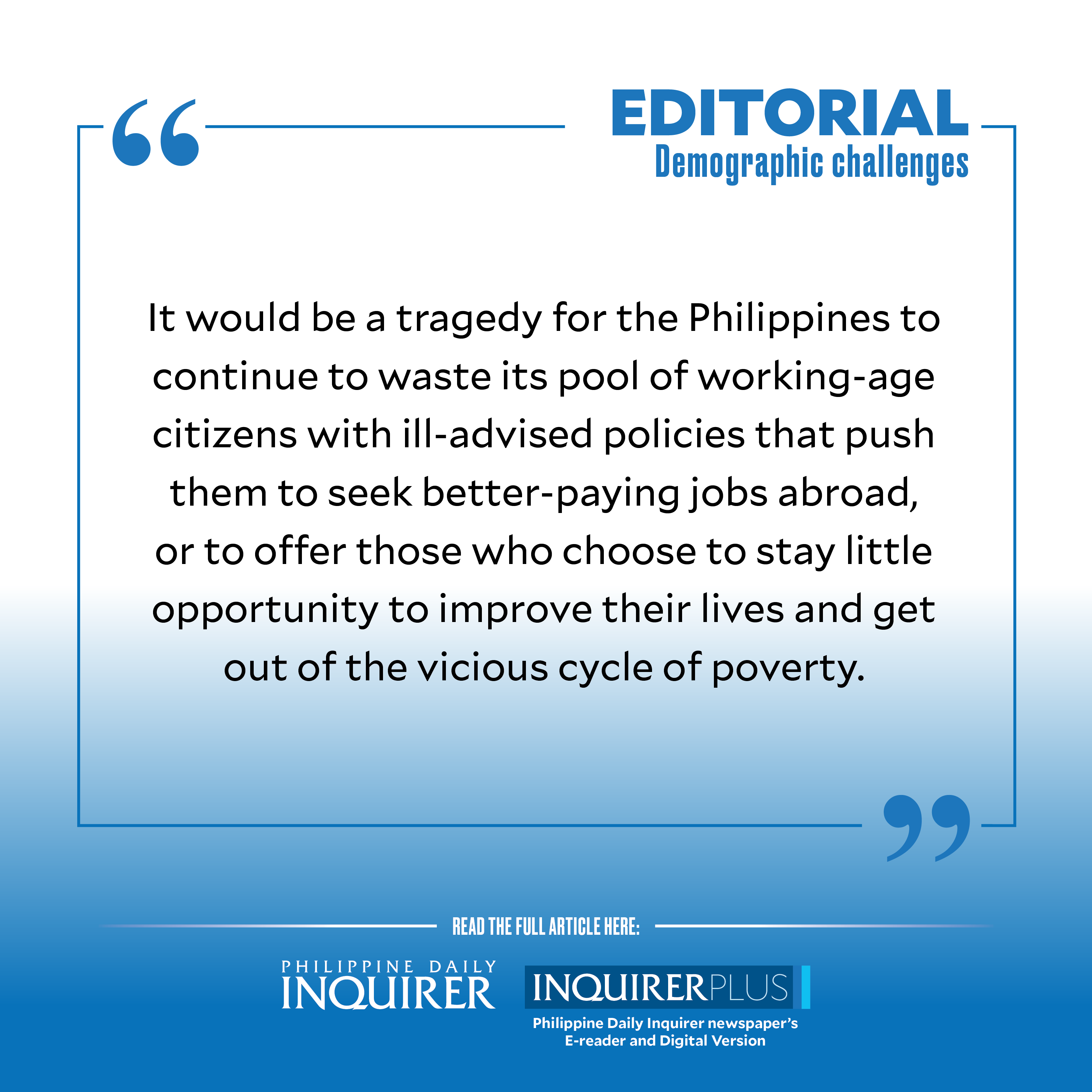Demographic challenges

Amid projections that the country’s population will reach 115 million by end of the year, from 109 million in 2020, Malacañang last week announced the approval of the Marcos administration’s long-term plan for managing and harnessing population growth to achieve its development agenda.
Memorandum Circular No. 40 directs all government agencies, local government units, and government-owned and -controlled corporations to “undertake efforts’’ to support the Philippine Population and Development Plan of Action (PPD-POA) 2023-2028, described as the “overall blueprint for inter-agency collaboration to optimize demographic opportunities and address remaining population challenges.”
Article continues after this advertisementThe Commission on Population and Development (CPD), as the Commission on Population or PopCom is now called, will be the plan’s lead implementing agency.
The creation of a plan of action is indeed necessary, as the Philippines, according to CPD deputy executive director Lolito Tacardon, is now the 13th most populous country in the world, and the seventh in the Asia-Pacific region.
What is more interesting, however, are findings that the country’s fertility rate has slowed down, and that majority of the population belong to the working-age group. Such findings have raised hopes that with the right conditions, the Philippines will reap the so-called demographic dividend, or economic growth brought about by changes in the characteristics of the population.
Article continues after this advertisementThe results of the 2022 National Demographic and Health Survey showed that the total fertility rate of Filipino women aged 15 to 49 has declined from 2.7 children in 2017 to 1.9 children in 2022, or below the replacement level of 2.1. It also indicated a steady decline from 6.0 children in 1973.“
Total fertility [in the Philippines] showed that a woman of reproductive health normally gives birth to two children only … This means that the total fertility level slows down the country’s population growth,’’ said Tacardon.
Experts have yet to determine whether the lower fertility rate could be attributed to the successful implementation of the reproductive health law during the Aquino and Duterte administrations, or the economic shock dealt by the global COVID-19 pandemic, which forced already hard-up families to tighten their expenses and made couples postpone having more children.
Tacardon pointed out that the decrease in fertility rate has a bearing on the age structure, so that the “dominant” sector of the population now belong to the working group aged 15 to 64, while dependents, those aged zero to 14, “are getting fewer in number.” This means, he said, that if the country becomes successful in harnessing the working-age population, “there is a chance to accelerate economic development.’’
“If all or many are working, all will contribute to development rather than [be among those] receiving help from the government,’’ Tacardon said.
That, in sum, is the big IF. Although we’re on our way to experiencing the so-called demographic sweet spot—when the optimal number of the population is of working age with few dependents—the country’s high unemployment rate, pervasive poverty, and other socioeconomic woes will make it impossible to reap the much-desired demographic dividend.
As United Nations Population Fund (UNFPA) country representative to the Philippines Dr. Leila Joudane noted, the Philippines is at a “unique crossroads with its changing demographics,” with a declining fertility rate providing “a window of opportunity [to have a] productive population larger than the dependent population.”
UNFPA however cautioned that “[t]he demographic dividend is not automatic. The country will have to make the right investments and policy decisions in order for it to reap its benefits, by investing in people throughout their life course.’’
Joudane stressed that while the demographic dividend “can be a powerful force …[to be able] to reap its benefits, we need to ensure the rights of people—especially those most left behind—and provide access to quality education, health care, and employment opportunities. We need to also address gender inequality and other injustices that limit people from reaching their full potential.’’
The challenge then to the Marcos administration is clear. The policies and programs spelled out or contained in the PPD-POA are most effectively achieved if the government were to work harder to curb unemployment and create job opportunities right here in the country.
It would be a tragedy for the Philippines to continue to waste its pool of working-age citizens with ill-advised policies that push them to seek better-paying jobs abroad, or to offer those who choose to stay little opportunity to improve their lives and get out of the vicious cycle of poverty.
As long as the government depends heavily on overseas Filipino workers to keep the economy afloat instead of providing decent jobs to lift millions from poverty, all these plans of actions will be good only on paper and will remain as unfulfilled promises.
















